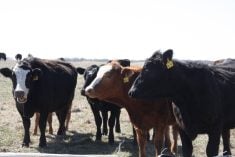This cattle market information is selected from the weekly report from Canfax, a division of the Canadian Cattlemen’s Association. More market information, analysis and statistics are available by becoming a Canfax subscriber by calling 403-275-5110 or at www.canfax.ca.
Fed market down
Cash and futures markets fell again last week.
Some analysts say the supply and demand fundamentals are more bullish than the current falling prices indicate.
The Canadian cash fed market has fallen 11 percent over four weeks to around $140 per hundredweight.
Read Also

Volatile temperatures expected for this winter
DTN is forecasting a lot of temperature variability in the Canadian Prairies this winter. Precipitation should be close to average.
The steer weighted average was $142.70 per hundredweight, down $10.74, and heifers average $141.24.
Fed prices were last below $150 in May 2014.
The market has declined slightly more than 20 percent from the highs in January.
New lows in Chicago live cattle futures and softer cash trade midweek in the United States took the wind out of the local fed market’s sails.
Most dressed sales were $238-$240 delivered, generally $12 lower than the previous week.
The Alberta-Nebraska cash-to-cash basis widened to -$5.45 from -$1.50 the previous week.
It is common to see basis levels at the strongest levels now and seasonally weaken into the third quarter.
Fed cattle exports to the United States have slowed as packers consistently kill five days a week and the basis remains strong enough to keep cattle in Canada.
Fed supplies will likely increase this summer, and market lows are still likely to come in August or September.
U.S. fed trade was scattered last week, and the market tone was steady to higher as the week progressed.
Midweek dressed sales in the northern U.S. started out US$10-$13 per hundredweight lower with prices in the mid $180s. However, bids moved up to $190 later in the week.
Live sales in Texas and Kansas were reported at $115-$116, down $6-$7.
Extreme heat in parts of the U.S. is forcing more cattle onto the market. The weekly average steer dressed weight to June 11 was 864 pounds, unchanged from the previous week and down five pounds from a year ago.
American packers remain profitable, and the last two weeks have seen the biggest kills this year.
Cows down
Lots of slaughter cows were at auction.
D1, D2 cows ranged C$92-$104 per hundredweight to average $98.10, down $4.30
D3 cows ranged $80-$95 to average $88.08.
Dressed bids were spotty and sharply lower at $180–$185 per hundredweight delivered.
Butcher bulls fell $3 to $122.56.
Weekly western Canadian slaughter to June 18 was steady at 5,400 head.
Weekly exports to June 11 dipped to 4,239 head.
Packers are focusing on the fed kill and appear to have comfortable supplies of slaughter cows.
Feeders lower
Alberta average steers fell more than $7 per hundredweight, and heifers were $5.50 lower.
Falling live cattle futures have also weighed on feeder prices.
Reduced feeding profitability has quelled buying interest. Weekly sale volumes of 11,176 head were seven percent smaller than the previous week and 11 percent lower than a year ago.
Reduced lot size and quality also contributed to lower prices.
Auction volumes will seasonally bottom over the next four weeks.
Calf prices were $4-$7.50 lower.
Feeder steers heavier than 700 pounds fell $5-$9.
Weekly feeder exports to June 11 seasonally declined to a modest 2,672 head.
Interest for all types of feeders is expected to wane as long as the futures market remains weak.
Some auction markets in July will seasonally close, and feeder volumes will slow to a trickle.
U.S. beef lower
Choice closed June 23 at US$215.46, down $8.02, and Select was $198.34, down $4.41. Beef could continue to fall, given the weaker cattle prices and large slaughter activity.
Weekly Canadian cutouts to June 17 were mixed with AAA up C$4 at $290.67 and AA down $6.42 at $258.31.














